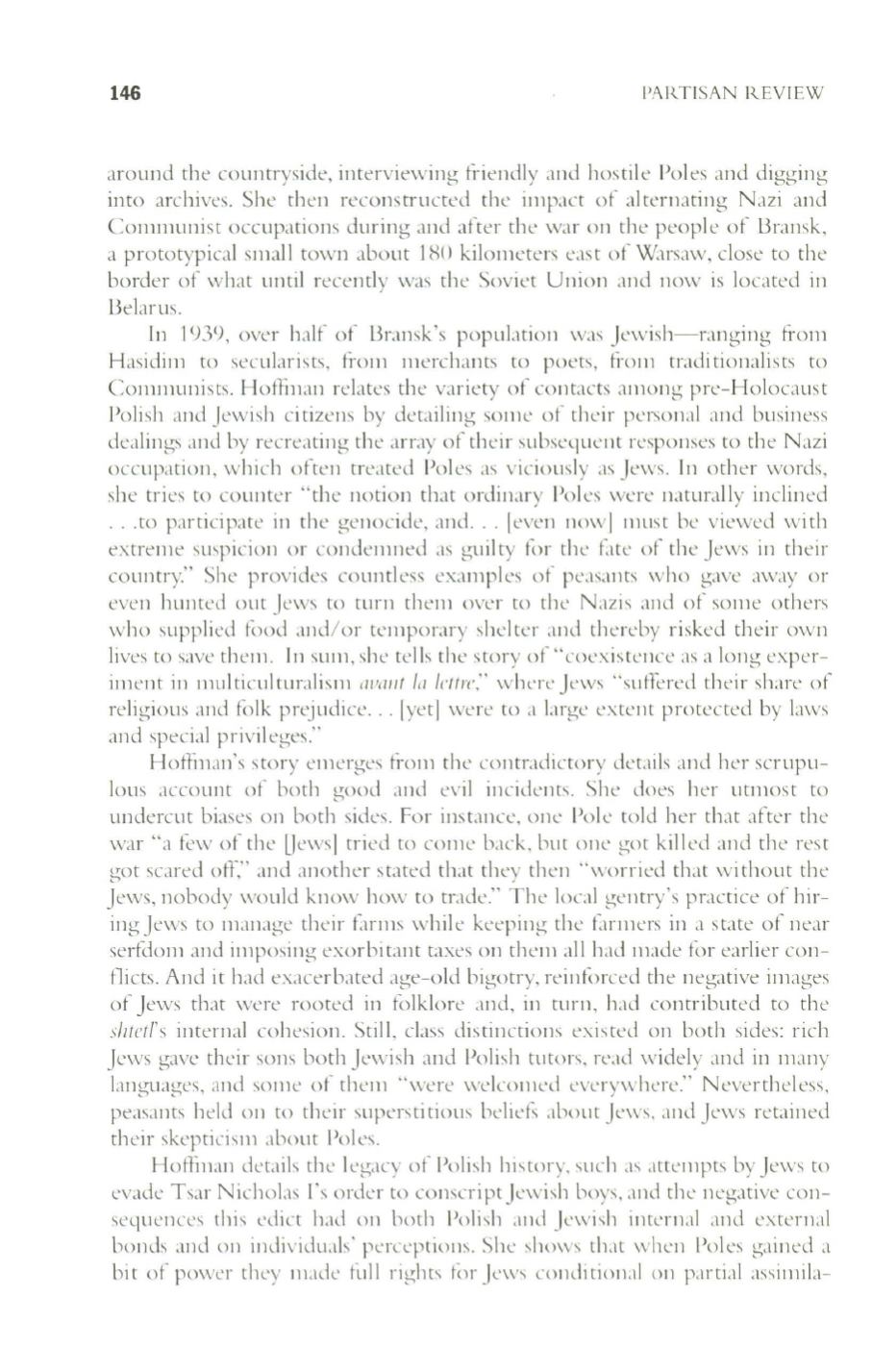
146
I'AlnlSAN R.EVIEW
around the countryside, interviewing fi-iendly and hostile Poles and digging
into archives. She then reconstructed the illlpact of al ternating Nazi and
COllllllunist occupations during and after
till'
war on the people of l3ransk,
a prototypical slllall town about 1
~()
kilometers cast of Warsaw, close to the
border of what until recently was the Soviet Union and now is located in
l3elarus.
In 1<)3<), over half of l3ransk's population was jewish-ranging frolll
Hasidilll to secularists, fi-olll ll1erchants to poets, fi-onl traditionalists to
Communists. Hoflinan relates the variety of contacts all10ng pre-Holocaust
Polish and jewish ci tizens by detailing sOllle of their personal and business
dealings and by recreating the array of their subseljuellt responses to the Nazi
occupation, which often treated Poles as viciously as jews. In other words,
she tries to counter "the notion that ordinary Poles were naturally inclined
..to participate in the genocide, and ... leven nowl lnust be viewed with
extrellle suspicion or condell1ned as guil ty for the f;lte of the jews in their
country" She provides countless examples of peasallts who gave away or
even hunted out jews to turn thelll over to the Nazis and of sOll1e others
who supplied f(lod andlor temporary shel ter and thereby risked their own
lives to save thelll. In sunl, she tells the story of "ulL'xistence as a long exper–
illlent in Illu lticu lturalislll
II/h1111
!o
!eflre,"
whLTL' jews "suffered their share of
religious and folk prejudice... Iyetl were to a large extellt protected by laws
and special privileges ."
Hoffinan's story elllerges fi-OIn the contradictory details and her scrupu–
lOllS account of both good and evil incidents. She does her utmost to
undercut biases on both sides. For instance, olle Pole told her that after the
war "a few of the Uewsl tried to comc b:lCk, but one got killed and the rest
got scared off' and another stated that they then "worried that without the
jews, nobody would know how to trade." The local gentry's practice of hir–
ingjews to Inanagc their f;mlls while keeping the f;mners in a state of near
serfdolll and imposing exorbitant taxes on thelll all had made ft.lr earlier con–
flicts. And it had exacerbated age-old bigotry, rL'infilrced the negative images
of jews that wt're rooted in folklore :lIld, in turn, had contributed to the
sizlefl's
internal cohesion. Still, class distinctiolls existed on both sides: rich
jews gave their sons both jcwish and Polish tutors, rcad widely and in many
languages, and
SOIllC
of theln "were \\'elcolned L'verywllL're." Nevertheless,
pe,lsants held on to their ,upersti tious belief, about jcws, and jews retallled
their skepticislll about Poles.
HoflllLln det.lils
till'
legacy of Polish history, such as .1ttempts by jews to
evade Tsar Nicholas l's order to conscri pt jewish boys, and the negative con–
sequences this L'dict had on both Polish allli jcwish illtern.ll and cxternal
bonds and on individu:ds' perceptiOlls. She shows th:lt when Poles gained a
bit of power thcy In.lde full rights filr jcws condition.ll on p.lrtial assilllila-


